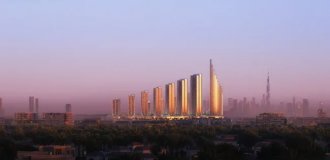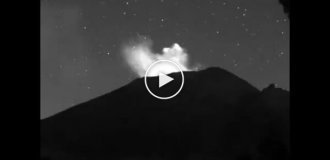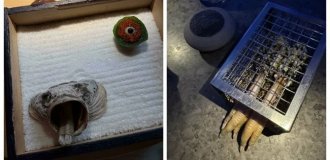Nikolaev, Ukraine (36 photos)
This is a difficult city - until 1992 it was the center of large shipbuilding, both civil and military. It can even be called the incubator of the USSR ocean fleet (surface) - many large ships were built there, which formed the backbone of the Northern, Black Sea and Pacific fleets. It was there that the largest ships were built - aircraft-carrying cruisers and helicopter carriers, and full-size aircraft carriers (unfinished due to the collapse of the USSR) were also laid down there. Therefore, the collapse of the Union led to a colossal blow to Nikolaev - the majority of the population employed in shipbuilding became unclaimed, and many became unemployed, the city economy fell into a deep depression, which even led to the suspension of tram traffic in the 1990s. Many civil project ships laid down were also stopped in construction.

Source: Zhzhurnal/periskop
The Large Fleet of the USSR was built mainly by two large plants - named after 61 Kommunara and Chernomorsky (ChSZ). We visited the environs of both shipbuilding giants, so there will be two parts for each plant. In addition, later I will try to tell you about Nikolaev in general. Now - a story about a hike around the perimeter of the 61st Communard shipyard. We will see it from land (from the city side), and then we will go to the pontoon bridge across the Ingulsky estuary and see the water area of the plant and the unfinished Soviet missile cruiser Project 1164, now “Ukraina”.

1. Big Shipbuilding in Nikolaev as a whole looks like this: one plant is located in the north of the city (named after 61 Kommunara, number 1), the second - ChSZ - in the south (number 2). The city itself is located between two large factories. I marked the water areas of the factories in blue to make it easier to see; The only thing is that ChSZ grabbed a little extra from the east - that’s why the space to the right of the number 2 is not ChSZ, it’s already a seaport. The 61 Kommunar plant is approximately equal in scale to the Baltic Plant in St. Petersburg; it was a large, powerful plant under the USSR. ChSZ is generally a supergiant, equal only to the Severodvinsk SMP; there are no other analogues in the ex-USSR. The story about ChSZ will be in the next part. Well, now - let's go.

2. From st. We will go north along Bolshaya Morskaya along a wide boulevard (more precisely, Sadovaya Street), at the end of which you can see a beautiful Stalinist building with a spire, somewhat similar to the St. Petersburg Admiralty.

3. This is the factory administration building of the plant, founded in 1788, and received its current territory in 1920, after the merger of three shipyards. In Nikolaev they really call it that - the Admiralty.

4. Opposite is a beautiful college building. If I understand correctly, before, under the USSR, it was a naval school (or technical school).

5. A ship on the building of the Nikolaev Admiralty.

6. In front of the entrance is a bust of Grigory Potemkin.

7. The design of the Admiralty fence is nautical, with anchors.

8. Now let's go to the right, along the perimeter of the plant, along the street. Admiral's She is now sleepy and quiet.

9. Between the Admiralty and the main factory entrance there are bas-reliefs and compositions from the times of the plant’s heyday (60-80s). Below Lenin, something has been torn off and covered up; before, there was clearly something else here.

10. Bas-reliefs of characters from the times of the Revolution.

11. Compositions on revolutionary themes.

12. The same thing further, but the theme is already from the 1960s - “space”, icebreaker “Lenin”, “atom”.

13. A memorial plaque explaining the name of the plant, as well as an anniversary plaque, 1967.

14. And here is the main entrance of the plant. It's quiet here, only rarely does a car pass by...

15. Monumental entrance gate at the entrance. On the sides are some mermaid horses.

16. Opposite the plant, along Admiralskaya, there is a line of old houses, perhaps even pre-revolutionary.

17. Even further from the factory headquarters is a very spacious, quiet and semi-abandoned square with a monument to the communards in the center.

18. The monument is painted and it is clearly visible that it has not been looked after for a long time.

19. Behind the monument is an alley. I was amazed by such a brazen combination of signs. At least the previous inscription was completely covered up, or something...)

20. Now let’s return to the Admiralty building and go left along the street. Along the perimeter of the plant stretches Naberezhnaya Street, gradually descending to the Ingulsky Estuary.

21. Behind the fence you can see numerous immovable cranes and plant structures.

22. Then the edge of the plant touches the center (I don’t show it here, this is the topic of another post) and goes down to the estuary. From the observation deck it looks very much like a Kremlin or a fortress.

23. Revolutionary composition with the battleship Potemkin on the corner.

24. And now we go down from the top of the hill to the estuary. The plant is to the right of the frame, its water area is slightly visible, and the pontoon bridge is slightly visible in front. Next is Victory Park.

25. Here he is, closer (zoom). In fact, the bridge is quite long, it’s just that the zoom has changed the proportions.

26. Bridge from the shore of the estuary.

27. Let's go to it. It is blocked off with barriers to prevent motorcyclists from racing.

28. Now let's look at the water area of the plant. The southern and eastern parts of it are shown here.

29. In the distance to the right are huge inclined stocks for the construction of large ships (cruiser class, BDK, BOD). On the left are some of the docks.

30. Unfinished Soviet-era buildings, northern part of the water area.

31. Paired inclined slipways, closer. They are empty, the plant is standing still.

32. To the right of the slipways, near the wall, stands the unfinished missile cruiser Project 1164. In post-Soviet times it was named “Ukraine”, but it is clear that no one completed it. The huge state ended, the fleet degraded, production stopped, and such powerful ships were no longer needed by the small, impoverished splinter country.

33. Composition with “Ukraine”, to the right you can clearly see the Admiralty with its spire, which we saw from the other side at the beginning of this hike.

34. If you look closely, you can discern the half-erased, rusted name of the ship.

35. Let's leave the bridge and see the Ingulsky estuary and the pontoon bridge again, from the shore.

36. Closer to the Bug Estuary there is a high road bridge with some kind of structure in the middle. I thought that there must be a drawbridge, otherwise how can such large ships be taken from the factory to the open sea from here.





















